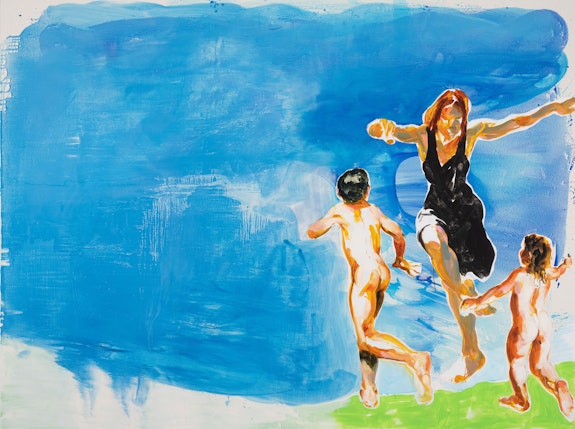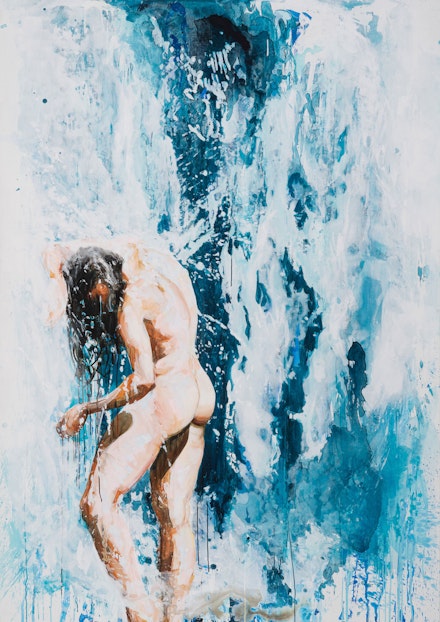ArtSeen
Eric Fischl: Meditations on Melancholia

On View
SkarstedtOctober 27– December 18, 2020
New York
A comely, long-haired nude standing beneath a cascade of water isn’t the sort of image that comes readily to mind when someone mentions artist Eric Fischl. For the better part of his career, the 72-year-old painter has been limning evocative scenes peopled with young boys, suburban parents, art world denizens, and his close friends, as well as Italian priests, Spanish matadors, and Indian dancers. Because many of his figures appear in settings with backyard swimming pools or the ocean, a range of blues dominates his works. Frequently, his subjects are more memorable than his technique.

That’s partly why the shapely brunette is noteworthy. Featured in Fischl’s recent solo show at Skarstedt’s luxe East 64th Street showrooms, the painting impresses as a tour-de-force of pictorial skill. Besides being fetching, the practically life-size figure transforms viewers into characters from mythology and the Bible who furtively spied on women bathing outdoors. Moreover, the streaming water not only looks remarkably wet, the torrent roars thunderously. With this painting, Fischl has entered territory associated with the Old Masters. So many other painters of his generation haven’t upped their games this way. As he’s become more technically proficient, Fischl’s themes have become more universal. He’s become less of a storyteller and more of an observant philosopher.
Several paintings and works on paper in Fischl’s solo show further reveal how his attitude has changed vis-à-vis the application of acrylics and oils to linen grounds. Consider the sky as well as the three figures in Inexplicable Joy in the Time of Corona (2020) or the sky, clouds, and body of water in Preparing to Swim the Channel (2020). The blues are so fluid that they call to mind watercolors pooling on paper. You’ll find lots of exposed surface around the tops, bottoms, and sides of the pictures, and much of what he’s painted lacks fine detail. It’s almost as if the paintings have been left deliberately unfinished.
The trio of paintings in a small, side gallery on the second floor offered their own astonishments. There’s nothing static about these ladies. They twist, turn, swirl, gyrate, as if they were wind-up toys that had just been activated. Although you can clearly discern the women in these single-figure studies, the paint has become so amorphous that you’re as aware of color—reds, yellows, blues—as form.

Has Fischl ever consistently worked so loosely, with such abandon? Given the title of the show—Meditations on Melancholia—it’s probably not surprising to learn that many of the paintings and works on paper were executed during the COVID-19 lockdown last spring and summer. To be sure, his blues add a critical subtext to the proceedings. Plus there’s an “edge” to many of these works. Are they meant to look unfinished? Should you believe that there’s an accompanying scenario in which the artist was interrupted before he could complete these pictures? Fortunately, for us, Fischl tried something new and succeeded gloriously.

